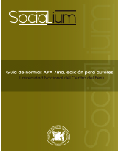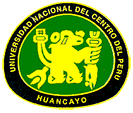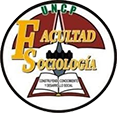Consumption of scrap foods and food attitudes of higher level students. University
DOI:
https://doi.org/10.26490/uncp.sl.2018.2.1.734Keywords:
junk foods, food attitudes, self-care of food, preventionAbstract
Objective: To determine the relationship between the consumption of junk foods and the alimentary attitudes in the students of the University of Huánuco; in 2014. Methods: the study was observational, analytical and cross-sectional; with correlational design. The population consisted of 1342 university students of Health Sciences; whose sample was selected probabilistically and stratified were 298 students to whom it was applied: an interview, a questionnaire of junk food consumption and a scale of food attitudes; previously validated and reliable. The ethical considerations of the investigation were applied. Descriptive and inferential analysis was carried out using the Rho correlation coefficient of Spearman, after normality of kolmogorov-Smirnov, supported by the SPSS V19. Results: 79, 3% (237) of the sample, indicated consuming junk foods. 75.6% (226) expressed positive food attitudes. The overall correlation was analyzed between the variables: junk food consumption and food attitudes, obtaining a significant low level correspondence (Rho = 0, 174 and p = 0.003); also, with the same tendency, between the consumption of junk foods and diet as a dimension of dietary attitudes (Rho = 0.195), this being significant (p = 0.001). There was no correlation between the consumption of junk foods and the dimension traits of bulimia- concern for food and oral control as part of the food attitudes. Conclusions: There is a low significant relationship between the consumption of junk foods and the nutritional attitudes of university students, which is why healthy eating policies must be implemented.
References
Álvarez Munárriz, L., & Álvarez de Luis, A. (2009). Estilos de vida y alimentación. Gazeta de Antropologia, 25, 11-17.
Burga Guzmán, D. R., Sandoval Rubiños, J. E., & Campos Bravo, Y. L. (2017). Estilos de Vida de las Adolescentes de una Institución Educativa de Chiclayo. Acc Cietna: Para el Cuidado de la Salud, 4(1), 23-38.
Domínguez Vásquez, P., Olivares, S., & Santos, J. (2008). Influencia familiar sobre la conducta alimentaria y su relación con la obesidad infantil. Arch latinoam nutr, 58(3), 249-255.
Espinoza, L., Rodríguez, F., Gálvez, J., & MacMillan, N. (2011). Hábitos de alimentación y actividad física en estudiantes universitarios. Rev Chil Nutr, 38(4), 458-465.
Hidalgo, M., & Güemes, M. (2011). Nutrición del preescolar, escolar y adolescente. Pediatr integral, 15(4), 351-368.
Ministerio de Salud. Lineamientos de gestión de la estrategia sanitaria de alimentación y nutrición saludable [Internet]. [Consultado 2018 Mar 06]. Disponible en: https://www.minsa.gob.pe/portalweb/06prevencion/est_san/archivo/Lineamientos%20_ESNANS_FINAL.pdf. In.
Moliní Cabrera, D. (2007). Repercusiones de la comida rápida en la sociedad. TCA(6), 635-659.
Montero Bravo, A., Úbeda Martín, N., & García González, A. (2006). Evaluación de los hábitos alimentarios de una población de estudiantes universitarios en relación con sus conocimientos nutricionales. Nutr Hosp, 21(4), 466-473.
Morales, G., Del Valle, C., Soto, Á., & Ivanovic, D. (2013). Factores de riesgo cardiovascular en estudiantes universitarios. Rev Chil Nutr, 40(4), 391-396.
Oliva Chávez, O. H., & Fragoso Díaz, S. (2013). Consumo de comida rápida y obesidad, el poder de la buena alimentación en la salud. RIDE, 4(7), 176-199.
Orem, D. E., Taylor, S. G., & Renpenning, K. M. (1995). Nursing concepts of practice. Rev Invest, 2(3), 65-93.
Organización Mundial de la Salud, & Organización Panamericana de la Salud. La OMS insta a tomar acción a nivel mundial para reducir el consumo de las bebidas azucaradas y su impacto sobre la salud [Internet]. [Consultado 2018 Dic 12]. Disponible en: https://www.paho.org/hq/index.php?option=com_content&view=article&id=12600:who-urges-global-action-curtail-consumption-sugary-drinks&Itemid=135〈=es. In.
Strategic Research Center. El Consumo de Comida Rápida [Internet]. [Consultado 2018 Dic 12]. Disponible en: http://www.abc.es/gestordocumental/uploads/Sociedad/comida-rapida.pdf. In.
Tamayo Caballero, C., Alcocer, H., Choque, L., Chuquimia, A., Condori, P., Gutierrez, I., & et al. (2016). Factores y determinantes del consumo de comida chatarra en estudiantes de la facultad de medicina, enfermería, nutrición y tecnología medica, La Paz-Bolivia 2016. Cuadernos Hospital de Clínicas, 57, 31.
Urzúa, A., Castro, S., Lillo, A., & Leal, C. (2011). Prevalencia de riesgo de trastornos alimentarios en adolescentes escolarizados del norte de Chile. Rev Chil Nutr, 38(2), 128-135.
Vidal Marín, M., Díaz Santos Dueñas, A., Jiménez Serrano, C., & Quejigo García, J. (2012). Modificación de ciertas actitudes frente a la alimentación en estudiantes de enfermería tras cursar la asignatura de nutrición y dietética. Nutr Clín Diet Hosp, 32(1), 49-58.
Vitónica. Una correcta alimentación es cuestión de actitud [Internet]. [Consultado 2018 Dic 12]. Disponible en: http://www.vitonica.com/wellness/una-correcta-alimentacion-es-cuestion-de-actitud. In.
Downloads
Published
Issue
Section
License
Copyright (c) 2020 Mely Ruiz-Aquino , Henry Acero Valdez , Lucy Arce Allende, Rubén Darío Alania Contreras

This work is licensed under a Creative Commons Attribution-NonCommercial-ShareAlike 4.0 International License.








.jpg)















